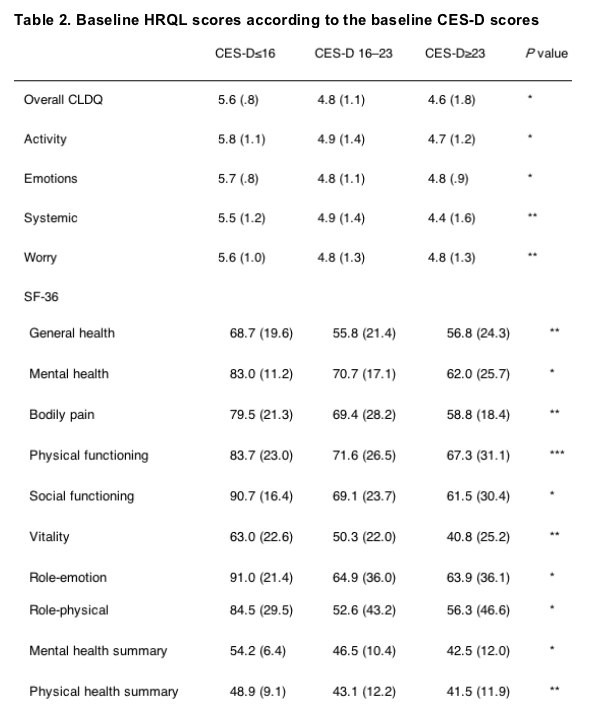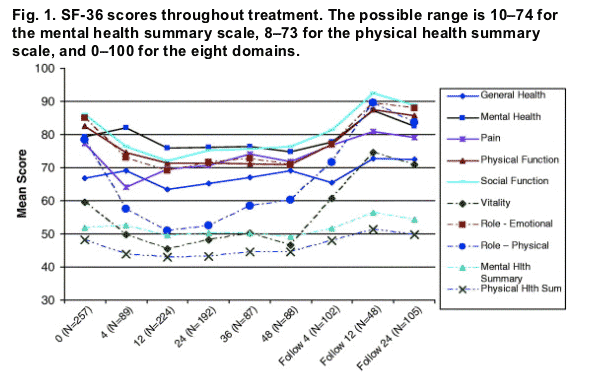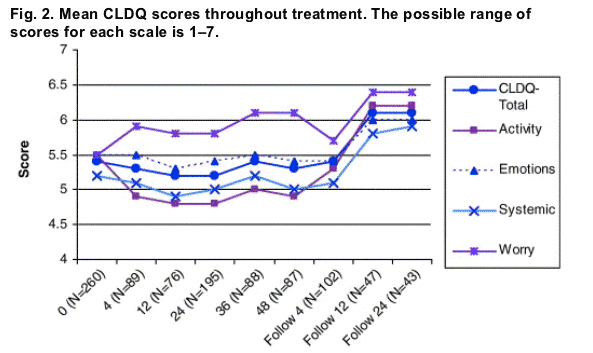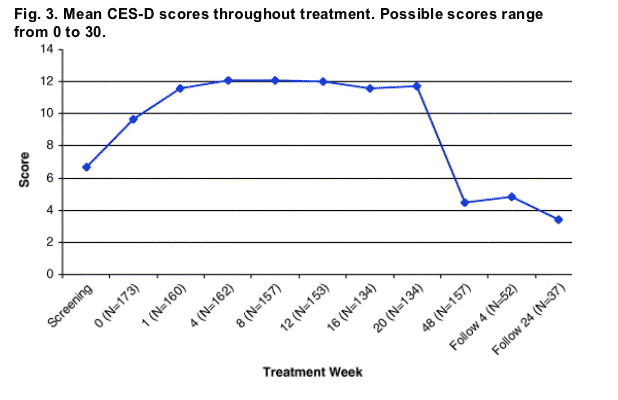| |
Depression, anemia and health-related quality of life in chronic hepatitis C: history of depression is most important predictor of quality of life & outcome for both on HCV treatment & before treatment in HCV+ individuals, study finds
|
| |
| |
Note from Jules Levin: the significance of this study is that it confirms the importance of properly evaluating depression & psychiatric issues for HCV+ patients before therapy, in preperation for HCV therapy, and during peginterferon/ribavirin therapy.
Journal of Hepatology March 2006
Amy A. Dana, Lisa M. Martina, Cathy Croneb, Janus P. Onga, Denise W. Farmera, Thomas Wiseb, Sean C. Robbinsc, Zobair M. Younossia
Author Discussion
Generally, HCV patients' HRQL (health-related quality of life) declined during antiviral therapy but returned to or exceeded baseline levels within 24 weeks of therapy completion. These changes in HRQL during HCV therapy are consistent with prior reports [3,21]. Findings also demonstrate the significant impact history of depression and current depressive symptoms have on HRQL impairment. The effects of depressive symptoms on HRQL were so strong that once depression was included in multivariate models, the effects of other factors, which were previously statistically significant, were no longer significant. Depressive symptoms also tended to increase with therapy initiation, pointing to the importance of screening for depression during therapy.
HRQL has previously been associated with sustained viral response [7] and disease-related worries [6]. Expanding on factors affecting HRQL, we found that obese patients with higher BMI and cirrhosis, as well as women, had more HRQL impairments in several domains [2,20]. HRQL scales were not associated with history of alcohol abuse, age, or race. In our study, very few HRQL domains were related to ALT and HCV RNA levels. These laboratory markers of HCV have not been consistently associated with HRQL impairment.
Finally, we assessed the impact of anemia on patients' HRQL. Anemia negatively affected disease-specific and generic aspects of HRQL. Nevertheless, the most consistent predictor of HRQL, even in the presence of anemia, was depressive symptomatology. This systematic assessment of depression has been lacking in previous studies of HRQL and anemia related to antiviral treatment.
Our data suggest that screening for and managing treatment-induced depression and anemia during antiviral therapy are important for the well-being of patients with HCV. Future studies are needed to see whether prevention and effective treatment of these side effects can help improve patients' HRQL or improve their adherence to antiviral therapy.
In summary, this in-depth analysis of HRQL and depression points to the negative impact of anti-viral therapy on these aspects of patients' lives. Although anemia can affect HRQL, depressive symptomatology was the most consistent predictor of HRQL. As we embark on strategies to treat patients with interferon-based regimens, interventions to improve patients' HRQL can enhance well-being, which may positively impact their treatment adherence. Interventions not only should include those targeting treatment of anemia but also the psychiatric side-effects of interferon.
Factors affecting HRQL at time of anemia
Stepwise regression was utilized to examine predictors of HRQL at time of anemia. First, the effects of age, gender, race, cirrhosis, HCV RNA and ALT levels, and BMI were considered and then history of depression and CES-D scores (continuous measure) were added to the equation. Those with a BMI≦30 had higher HRQL on five scales: activity, mental health, role-physical, social functioning, and physical health summary. Compared to patients with ALT levels ≥40, patients with ALT levels <40 had higher scores on the mental health summary scale and lower scores on physical functioning. Gender and race had no effects. When history of depression and CES-D scores were included, all other variables besides age were no longer significant. History of depression was associated with lower overall CLDQ, activity, worry, and social functioning. Greater depressive symptoms predicted lower emotional functioning, worry, mental health summary, mental health, and role-emotion.
Repeated measures ANOVA analyses were also undertaken to examine predictors of HRQL over multiple times (between subjects). Similar to the cross-sectional analyses, BMI, history of depression and depressive symptomatology were the most consistent predictors of HRQL. Patients with BMI ≦30 had higher average scores on the activity, systemic, pain, physical functioning and vitality scales. History of depression predicted lower average scores on overall CLDQ, activity, emotion, worry, role-emotion, role-physical, and social functioning. These relationships were only statistically significant for scores between baseline and anemia time point; patients' BMI and history of depression were not predictive of differences in average scores between the time of anemia and follow-up week 24.
CES-D scores (depression test) were predictive of overall CLDQ (average between baseline and anemia time only) (CLDQ is a liver disease-specific HRQL test evaluating activity, emotional function, systemic sysptoms, worry) as well as systemic (baseline and anemia), worry (baseline and anemia), general health (both-average between baseline and anemia and between anemia and follow-up week 24), mental health (both), physical functioning (both), role-emotion (both), role-physical (both), social functioning (both), pain (anemia and follow-up week 24), and vitality (anemia and follow-up week 24 only) scores (P<0.05). Generally, those with the lowest CES-D scores had the highest average HRQL scores on each scale, with those having high depressive symptoms (≥23) tending to have the lowest average HRQL scores on these scales.
Article Text
Hepatitis C (HCV) infected patients have significant health-related quality of life (HRQL) impairment which worsens during anti-viral therapy. Our aim was to examine the association of HRQL with treatment-induced depression and anemia. (note from Jules Levin: Coinfected patients (HCV/HIV) may experience worse depression and anemia before therapy & during therapy. In general coinfected patients are more likely to experience adverse events & side effects and may be more likely to discontinue HCV therapy. Therefore, management of these adverse events are more crucial in coinfection).
Introduction
Hepatitis C virus (HCV) affects approximately four million people in the United States, three-quarters of whom have chronic infection [1]. Annual health care costs associated with HCV have been estimated to be one billion dollars [1]. Given the number of HCV infected patients, the serious health problems commonly resulting from the disease such as cirrhosis and its complications, and significant economic costs, clinicians and researchers have become increasingly interested in understanding HCV's impact on patients' well-being.
HCV patients commonly experience fatigue, anxiety, and depression. These symptoms negatively affect patients' functional health, ability to work, self-perceived health, HRQL and well-being. Psychosocial issues and reduced HRQL are frequently experienced by HCV patients [2-4]. HCV patients have more HRQL impairment than the general population [2,3,5-7]. There is some evidence that HCV patients who experience greater fatigue, greater psychiatric symptoms, and poorer HRQL are more likely to discontinue treatment prematurely with its negative impact on virologic response [8,9]. In addition to well-known side effects of interferon, one important determinant of HRQL during anti-viral therapy for HCV is development of ribavirin-induced anemia [10-13]. Treatment of anemia improves HRQL, potentially impacting adherence to antiviral regimen and improving virologic response [10]. These issues emphasize the importance of investigating the physical and psychosocial experiences and HRQL of HCV patients.
ABSTRACT
In this in-depth study, the association of HRQL with depressive symptoms and anemia were assessed. Clinical and socio-demographic predictors of depression and HRQL were also examined.
Methods: Two hundred and seventy-one HCV patients who received pegylated interferon alfa 2b and ribavirin were included. Data on HRQL, depressive symptoms, laboratory values and socio-demographic characteristics were collected.
Results
Mean age was 47.1±6.5, 69% were male, and 73% were White. HCV patients' HRQL declined during anti-viral therapy but returned to or exceeded baseline levels within 24 weeks of completion.
Anemia and depression were both associated with HRQL impairment. The effects of depression on HRQL were strong; once depression scores were included other factors were no longer significant.
Patients' depressive symptoms tended to increase during the initial half of treatment regimen. Those with higher body mass index (BMI), cirrhosis, and women reported more HRQL impairments.
HRQL scales were generally not associated with alcohol abuse, age, race, ALT and HCV RNA levels.
Conclusions: Anti-viral therapy for HCV is associated with diminished HRQL. Although anemia and depression were associated with this impairment, depression was the most consistent predictor. Future studies are needed to see whether proactive management of these side effects can improve patients' HRQL and the efficacy of antiviral therapy for hepatitis C.
(note from Jules Levin: the use of EPO & anti-depressants can be effective in preventing or reducing depression. EPO can improve anemia by improving hemoglobin which can improve depression, and anti-depressants are used either before therapy begins as a prophylaxis for depression or after depression starts during therapy. There are differences of opinion about whether to initiate anti-depressants before therapy or after symptoms emerge.)
Methods
Two hundred and seventy-one patients with CH-C who received a regimen of pegylated interferon alfa 2b and ribavirin were included in this study. Survey data were prospectively collected in a standardized manner before antiviral therapy began; weeks 4, 12, 24, 36 and 48 during treatment; and 4, 12 and 24 weeks after the treatment regimen was completed. At the beginning of these office visits, patients completed questionnaires assessing HRQL, depressive symptoms, and demographics. Hemoglobin levels and other relevant clinical data were also recorded. Our Institutional Review Board approved the protocol.
Measures
HRQL
The short-form 36 (SF-36) health survey and chronic liver disease questionnaire (CLDQ) were used to evaluate HRQL.
The SF-36 [14] consists of 36 items measuring general health in eight domains: physical function, role limitations-physical, bodily pain, general health perceptions, vitality, social functioning, role limitations-emotional and mental health. Each scale has scores ranging from 0 to 100. SF-36 has good validity and reliability in chronic disease samples, including hepatitis C [2,3,15]. SF-36 is also divided into summary scores for mental and physical components. The mental health summary component ranges from 10-74 to 8-73 for the physical component. Higher scores on each scale reflect better HRQL.
The CLDQ is a liver disease-specific HRQL instrument comprised of 29 items reflecting four domains: activity, emotional function, systemic symptoms, and worry. Each item has responses ranging from 'all of the time' [1] to 'none of the time' [7]. An overall CLDQ score is also calculated. Scores on each scale range from 1 to 7. This instrument is valid and has good test-retest reliability [5,16,17]. Higher scores indicate better HRQL.
Depressive Symptoms
The 20-item Center for Epidemiologic Studies Depression Scale (CES-D) [18] was administered to patients. This is a valid and reliable measure for screening depressive symptoms in HCV populations [19]. Summary scores range from 0 to 30.
Clinical, demographic, and psychosocial data
Baseline clinical and demographic data were collected. The following variables were assessed as potential predictors of HRQL and depression: age, gender, race (Non-latino White, Black or other race), BMI, ALT level, HCV RNA level using polymerase chain reaction (PCR), cirrhosis, history of depression, history of alcoholism, and whether the patient was taking an anti-depressant/anti-anxiety medication. Cirrhosis was determined histologically by a liver biopsy prior to the initiation of antiviral therapy. Additionally, alcohol consumption was estimated by the quantity and frequency of alcohol intake. In addition to considering predictors of depressive symptoms, baseline CES-D scores were included as a predictor of HRQL. While actual depression scores were utilized when depression was an outcome, when used as a predictor, baseline CES-D scores were divided into three levels: low (CES-D scores≦16), moderate (>16 and <23), and high (≥23) [18].
Results
Demographic characteristics and clinical data are summarized in Table 1.

Cross-sectional analysis
Predictors of depressive symptoms
Age, race, gender, ALT level, BMI, HCV RNA level, and alcohol abuse history were not statistically significantly associated with depressive symptoms at baseline (P>0.05). Patients with a history of depression, those receiving anti-anxiety/anti-depression medication at baseline, and those with cirrhosis had greater depressive symptoms (means=11.4±7.7, 7.1±6.0, 11.5±7.8, respectively) than their counterparts (8.9±7.5, 3.8±4.1, 8.5±7.4) (P<0.05).
Predictors of HRQL
To assess factors affecting HRQL, two sets of regression analyses were conducted. Bivariate data indicated age, race, and history of alcohol abuse were not correlated with any HRQL domain, so they were excluded from multivariate analyses. The first regression analysis included gender, BMI, cirrhosis, ALT and HCV RNA levels as predictors. The second set of analyses added history of depression and baseline depressive symptoms as predictors (anti-depressant/anti-anxiety medication was excluded since it was confounded by baseline depressive symptoms).
Having a BMI ≦30 was significantly (P<0.05) associated with better HRQL, including overall CLDQ (5.6±.8 vs. 5.2±1.0), systemic symptoms (5.4±1.1 vs. 5.0±1.3), activity (5.7±1.0 vs. 5.3±1.3), worry (5.6±1.0 vs. 5.3±1.1), physical health summary (49.3±8.7 vs. 46.4±10.6), general health (69.3±18.4 vs. 61.9±21.5), pain (79.8±20.8 vs. 72.8±24.3), physical functioning (85.1±21.5 vs. 78.1±25.6), and vitality (61.9±22.3 vs. 55.2±23.2).
There were some gender differences (P<0.05) in HRQL, with men having better scores than women on four CLDQ and four SF-36 scales: overall CLDQ (5.5±0.9 vs. 5.2±1.0), activity (5.7±1.1 vs. 5.3±1.4), emotion (5.6±0.9 vs. 5.3±0.9), systemic symptoms (5.3±1.2 vs. 5.0±1.4), physical health summary (50.0±9.4 vs. 46.1±10.3), general health (69.1±18.6 vs. 61.2±21.3), role-physical (81.2±33.7 vs. 72.2±36.9), and vitality (61.8±22.6 vs. 54.0±22.8).
ALT and HCV RNA levels were only associated with a few HRQL scales. Patients with an ALT level <40 had higher scores on the emotion (5.9±0.5) and mental health subscales (84.7±10.1) than those with an ALT level ≥40 (5.5±0.9 and 79.0±14.0) (P<0.05). Patients with low viral load (HCV RNA<850,000IU/ml) had higher scores than those with high viral load: activity (5.7±1.1 vs. 5.4±1.2), mental health summary (52.9±7.1 vs. 50.4±8.6), pain (79.9±21.2 vs. 74.6±23.4), role-emotion (88.2±25.0 vs. 80.8±31.9) and vitality (62.6±23.5 vs. 55.6±21.9) (P<0.05).
Patients with cirrhosis had lower average scores on six scales: general health (62.0±21.7 vs. 69.0±18.3), physical functioning (76.2±26.7 vs. 85.3±21.9), role-physical (67.8±40.1 vs. 83.4±31.1), physical health summary (44.9±10.8 vs. 49.4±9.0), vitality (52.9±25.7 vs. 62.7±20.6), and activity (5.2±1.4 vs. 5.7±1.1) compared to those without cirrhosis (P<0.05).
In the second analysis, history of depression and baseline depressive symptoms were highly predictive of HRQL (P<0.05). Patients with a history of depression had poorer HRQL as measured by overall CLDQ (5.1±0.9 vs. 5.6±0.9) and three of its subscales (5.1±1.3 vs. 5.8±1.1 on activity, 5.1±0.8 vs. 5.6±0.9 on emotion, and 5.1±1.0 vs. 5.6±1.1 on worry). History of depression also predicted lower scores on seven SF-36 subscales: mental health (75.6±17.2 vs. 81.6±13.3), pain (71.4±23.3 vs. 79.2±22.2), physical functioning (72.2±29.4 vs. 84.7±21.7), role-emotion (76.1±32.7 vs. 89.6±24.1), role-physical (69.0±42.6 vs. 82.7±30.9), social functioning (76.1±26.1 vs. 90.0±17.1), and vitality (53.4±21.9 vs. 63.0±23.4). Greater depressive symptoms also predicted lower HRQL as measured by the CLDQ and its four subscales and all the SF-36 scales. Table 2 provides the descriptives on HRQL scores by low, moderate and high levels of depressive symptoms. Once depressive symptoms and history of depression were added to the regression models, gender remained a significant predictor of only three scales (systemic, emotion, and general health), BMI of three scales (systemic, physical functioning, and pain), HCV RNA of two domains (mental health summary and vitality), ALT of one domain (emotion), and cirrhosis of no domains.

Longitudinal data
Changes in general HRQL
Average SF-36 scores at each time point are summarized in Fig. 1. Generally, scores on the SF-36 subscales were lower during treatment than at baseline and the period after antiviral therapy was completed. Vitality, physical functioning, and social functioning scores were statistically significantly lower during treatment relative to baseline and all three points after treatment ended. Social functioning, vitality, and physical functioning scores were at similarly lower levels each week of treatment.

Similarly, patients experienced more pain and had more limitations in role-physical and role-emotion during treatment compared to baseline. Pain, role-physical and role-emotion scores improved after treatment.
Patients' general health was higher at follow-up week 24 than at baseline, all weeks of treatment (except week 4; scores were not statistically significant), and follow-up week 4. Baseline general health ratings did not differ from ratings during treatment. Patients' general health was lower at weeks 36 and 48 of treatment compared to 4-weeks after treatment ended, and lower at weeks 12 and 36 compared to 12 weeks after treatment completion.
Patients' baseline overall mental health scores were significantly higher than during all weeks of treatment (except week 4) and follow-up week 4. Mental health scores at follow-up week 24 were higher than all weeks of treatment and follow-up week 4. During treatment, the only difference in scores was that week 24 scores were higher than at week 48.
Turning to physical health summary scale, baseline scores were higher than scores throughout treatment but did not differ from scores once treatment was completed. Physical health scores after therapy was finished were higher than were scores throughout therapy (exception was scores at week 48 did not differ from follow-up week 4). Physical health scores did not vary much during treatment.
Changes in disease-specific scores
Patients' average CLDQ scores are in Fig. 2. Overall CLDQ scores were higher at baseline than during all weeks of treatment. Additionally, CLDQ scores were lower during treatment than the follow-up period.

Patients experienced more worry (lower scores) at baseline than during all weeks of treatment and follow-up weeks. Patients were more worried in the early weeks of therapy than at the end of treatment and after completing treatment.
Emotional function scores were lower at baseline and during treatment than after treatment completion. Activity/energy scores were higher at baseline than during antiviral therapy. Additionally, activity/energy scores were lower during treatment compared to post-treatment completion.
Baseline systemic symptom scores were higher than scores during treatment and follow-up week 4 (no difference between follow-up weeks 12 and 24). Systemic symptom scores were lower during treatment than after treatment completion. During therapy, systemic symptom scores did not vary much; only scores at treatment weeks 24 and 36 were higher than those at week 48.
Changes in depressive symptomatology
Average CES-D scores for each time point are in Fig. 3. Depressive symptoms increased during the first half of treatment (weeks 1-20) compared to baseline. Depressive symptoms were higher at baseline and the first half of therapy than after treatment completion (exception was that week 20 scores did not differ from follow-up weeks).

Anemia and HRQL
Incidence of low hemoglobin levels during therapy
Mild anemia was defined as a hemoglobin value≦12 during antiviral therapy. Fifty-nine percent of patients had a hemoglobin value≦12g/dL during treatment (N=157). For patients who had more than one hemoglobin value≦12g/dL, the week with the lowest hemoglobin level was identified as the 'anemia' time point. Average hemoglobin level at the time of anemia was 10.8±0.8g/dL. Of those who developed anemia, their average hemoglobin level at baseline and treatment week 4 were 14.9±2.6 and 12.0±1.2g/dL, respectively (P<0.05). Average hemoglobin level 24 weeks after treatment completion was 14.5±1.2g/dL. Hemoglobin levels at these three time points were statistically significantly different from each other (P<0.05). 83% of those who developed anemia did so during the first half of therapy (by week 24). Additionally, anemia patients had lower average hemoglobin levels at baseline (mean=14.9±2.6g/dL) and follow-up week 24 (mean=14.9±1.2g/dL) compared to non-anemic patients (means=15.3±1.2 and 15.8±0.8g/dL; t=3.3 and 3.3, respectively).
Of the anemic patients, two-thirds were White and 16% were Black. Mean age was 47 (range=25-66). Anemic patients were more likely to be female (39% vs. 20%), have a BMI≦30 (70% vs. 57%), and have an ALT level<40 at baseline (11% vs. 4%) compared to those who did not develop anemia (P<0.05). Average age, race, cirrhosis, HCV RNA levels, history of depression, and depressive symptoms did not differ between the two groups.
Effect of anemia on HRQL
HRQL scores were calculated at baseline, treatment week 4, the closest time point before and after the hemoglobin drop, and 24 weeks after therapy completion. Scores were compared at treatment week 4 (rather than just baseline) to control for the effects of interferon.
HRQL scores of anemic patients are in Fig. 4(A) and (B). Scores on all SF-36 and CLDQ subscales were significantly lower with development of anemia than baseline scores. These HRQL scores improved 24 weeks after discontinuing therapy (P<0.05). There were only three exceptions: no differences existed between general health scores at baseline and time of anemia and between worry scores from time of anemia and follow-up week 24; patients expressed greater worry at baseline compared to when they had anemia.
|
|
| |
| |
|
|
|